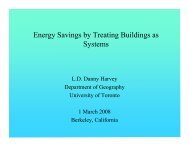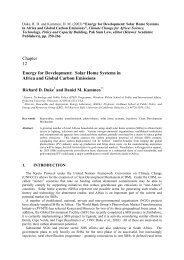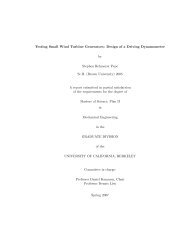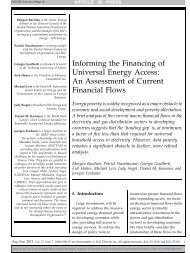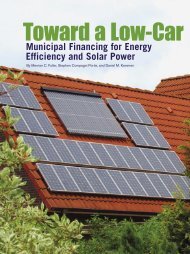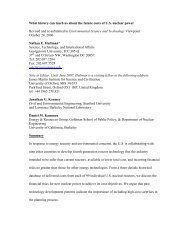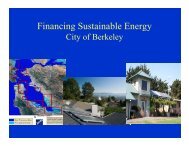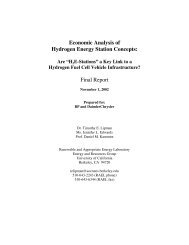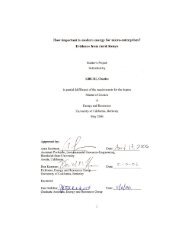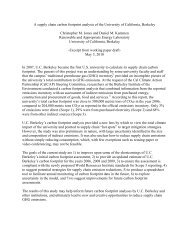Renewable Energy Sector Development in the Caribbean: Current ...
Renewable Energy Sector Development in the Caribbean: Current ...
Renewable Energy Sector Development in the Caribbean: Current ...
You also want an ePaper? Increase the reach of your titles
YUMPU automatically turns print PDFs into web optimized ePapers that Google loves.
management). We have shown here how focus on different policy doma<strong>in</strong>s <strong>in</strong> various islandtypes might lead to <strong>the</strong> design of such an enabl<strong>in</strong>g policy environment.Fur<strong>the</strong>rmore arguments are often put forward for liberalization and free competition on <strong>the</strong> basisthat state owned enterprises are <strong>in</strong>tr<strong>in</strong>sically <strong>in</strong>efficient and mismanaged. However practiceshows that ownership regime is far less important than <strong>the</strong> context with<strong>in</strong> which <strong>the</strong> enterpriseoperates. Competition <strong>in</strong> energy markets, signals to management and <strong>in</strong>centives, opportunitiesfrom capital markets can all improve utility behaviour (Gabriele, 2004). While <strong>the</strong> economics ofrenewables drive <strong>in</strong>vestment, <strong>the</strong> dynamic of contract negotiations <strong>in</strong> <strong>the</strong> face of uncerta<strong>in</strong>ty isalso a primary driv<strong>in</strong>g force (Barradale, 2010) (Wolf He<strong>in</strong>rich Reuter, 2012). For this reason wehighlight that policy security should be explicitly considered when design<strong>in</strong>g <strong>in</strong>centives topromote renewables <strong>in</strong> <strong>the</strong> <strong>Caribbean</strong>.There are a few island regions where energy policy has helped to promote <strong>the</strong> growth of arenewable energy <strong>in</strong>dustry, such as Cape Verde, Crete and <strong>the</strong> Hawaii Islands (Weisser &Garcia, 2005). In 2011 renewables supplied 24.5% of retail electricity <strong>in</strong> Hawaii (HawaiiElectricity Company , 2011). This penetration has been supported by a number of <strong>in</strong>itiativesimplemented by <strong>the</strong> major utility hold<strong>in</strong>g company and <strong>the</strong> public utility commission. S<strong>in</strong>ce <strong>the</strong>1990s Hawaii has seen <strong>the</strong> <strong>in</strong>troduction of a <strong>Renewable</strong> Portfolio Standard, net meter<strong>in</strong>gprograms, a feed-<strong>in</strong> tariff, a competitive generation bidd<strong>in</strong>g process, grid <strong>in</strong>terconnectionstandards and state and federal rebate schemes all tailored to each island (DSIRE, 2010). Thesecases highlight <strong>the</strong> potential success that can come from a complementary policy portfolio.In our discussion it is important to note that all of <strong>the</strong> <strong>Caribbean</strong> islands studied are <strong>in</strong> <strong>the</strong> veryearly stages of power sector reform and renewable energy <strong>in</strong>tegration, so it is difficult to judge<strong>the</strong> successes of <strong>the</strong> renewable energy <strong>in</strong>dustry. As our cost analysis has shown, <strong>the</strong>re are manyscenarios <strong>in</strong> which certa<strong>in</strong> renewable energy technologies already provide significant socialbenefit and are cost competitive with short run avoided costs. This would <strong>in</strong>dicate <strong>the</strong> potentialfor small scale resource development and profitability that can be precipitated by local<strong>in</strong>novation, local <strong>in</strong>vestment and local market <strong>in</strong>terest, all of which can be encouraged throughmore directed and enabl<strong>in</strong>g policy. These considerations warrant more thorough analysis thanpresented here<strong>in</strong>. We are currently develop<strong>in</strong>g an optimization model to explore <strong>the</strong> impacts ofpolicy portfolios on island grid systems but hopefully have provided useful <strong>in</strong>sight to this po<strong>in</strong>t.5. CONCLUSIONCARICOM, CARILEC, <strong>in</strong>ternational <strong>in</strong>vestors and local regulatory agencies will be key players<strong>in</strong> <strong>the</strong> development of future <strong>Caribbean</strong> energy policy. A sensitization to <strong>the</strong> differences <strong>in</strong> powersector dynamics outl<strong>in</strong>ed here<strong>in</strong> and a work<strong>in</strong>g knowledge of <strong>the</strong> success that can come fromsmall scale energy technologies will support <strong>the</strong>se groups. From our analysis, Grenada needsfocus to be placed on a greater degree of government <strong>in</strong>volvement <strong>in</strong> power sector regulation.16



